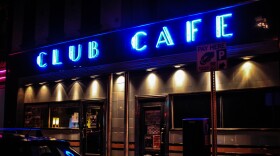Two massive stone arches tower over Washington Boulevard in Pittsburgh’s Homewood and Larimer neighborhoods. The intersecting structures over Silver Lake Drive appear out of place along this curving, concrete road.
Good Question! asker Jeff Jaeger from Glenshaw, Pa. noticed the giant spans near a car wash business and storage facility.
“I would like to know the story behind the beautiful stone arch bridges,” he asked.

More than 100 years ago, around the turn of the century, this part of Pittsburgh was bustling with rail lines. The taller bridge was built by the Pennsylvania Railroad and its chief engineer of construction, William Brown, according to Bruce Cridlebaugh with the blog PghBridges.com. Brown’s nickname was “the stone man.”

“[Brown] was determined to build in a permanent way,” Cridlebaugh said. “Built in stone and built to last.”
The 468-foot tall bridge was called the Brilliant Viaduct, after the small “Brilliant Branch” railway that used it to travel to a nearby oil refinery of the same name. The Brilliant Oil Refinery was one of the first in the world, Cridlebaugh said, and preceded the creation of the Standard Oil Company.
When the Brilliant Viaduct was finished in 1904, Pittsburgh was an industrial powerhouse. The railroad came through this part of town because so many of the mainline tracks downtown were congested. Cridlebaugh said engineers built shortcuts around downtown in places like Brunot Island over the Ohio River and Duquesne, Pa., over the Monongahela River.

Carp farming and ice skating
Next to the car wash along Washington Boulevard, a short dead-end street called Silver Lake Drive veers toward industrial-looking buildings and Westinghouse High School’s track and football field.
The name, Silver Lake, is a nod to a body of water that once occupied the space underneath the Brilliant Viaduct. When the span was built, streams flowed freely into Negley Run and down to the Allegheny River. Most of these streams have since been filled in or covered by roadways, but back then, a man named George Finley owned much of the land in this area, including Silver Lake.
This is part of our Good Question! series where we investigate what you've always wondered about Pittsburgh, its people and its culture.
Carp were grown in Silver Lake, according to Christine Mondor, principal with the firm Evolve Environmental Architecture. Finley actually wrote a book about how to farm fish in Silver Lake.
“He talks about how it’s an economic driver and how he had to figure out how to make it not flood,” Mondor said. “[Silver Lake] was beautiful, but also very functional.”

In the ABC of Carp Culture, Finley writes of his time perfecting his fish farm at Silver Lake. He tries raising fish in different seasons and debates how big they should be when they’re caught. He also sets a framework for any aspiring carp fishers to maintain their own lake.
“In appearance, the carp is a random handsome fish; its scales are large and well defined,” Finley wrote. “I have seen some large ones who caudal was of a beautiful orange, and blended off finely to a light yellow, pink or straw color.”
The lake itself was picturesque, Monor said, and served as a site for musical concerts, picnics and, in the winter, ice-skating.
“If you look online you can see postcards from back in the day and you see people who are dressed in their Sunday best looking over a lake that’s underneath these big stone viaducts,” Mondor said.
Little Lincoln Bridge
Sponsored by the Baum Boulevard Automotive, Eisler Landscapes, and the CPA firm Sisterson and Company.
The second span that runs below the Brilliant Viaduct is called the Lincoln Avenue Bridge. It was built a few years after its partner by the City of Pittsburgh when the Department of Public Works, under the tutelage of Edward Bigelow, was crafting its parks system. Bigelow is considered the architect of the city’s parks. He was responsible for convincing Mary Schenley to donate the land for the park of the same name and designed many of the grand boulevards that were meant to connect the region, including Allegheny River and Bigelow (then Grant) boulevards.
Because Silver Lake was so beautiful, Cridlebaugh said the city considered the area park-like and wanted to invest in a new span along Lincoln Avenue.
“The new bridge was consciously designed to be as picturesque as the Pennsylvania’s Railroad’s stone arch viaduct,” Cridlebaugh said.
Stealing popcorn from the drive-in

For several years, the two bridges stood over Silver Lake. In 1917, Westinghouse High School opened nearby, along with its athletic field, the Westinghouse Bowl. Old photographs of the campus show Silver Lake still equipped with docks.
But when the Great Depression arrived, the lake began to deteriorate and was eventually filled in and paved over.
Rev. Thomas Mitchell, a 69-year-old Homewood native and Westinghouse alum, remembers Silver Lake, but not for the water. Rather, the site where the lake once stood was turned into a 550-car drive-in movie theater. Mitchell said students could be a little mischievous at the movie theater.
“We would break in and steal popcorn,” Mitchell said. “But most of the families in this area, that’s where we went to the drive-in. Mom and dad would put your pajamas on and take you to the drive-in.”
Wanda Matthews, a 1970 Westinghouse grad, lived near the drive-in and on clear days, could watch movies from her bedroom window and sometimes even hear the audio.
“Back then, [movies] were cheap,” Matthews said. “We’d bring our pillows and blankets along the back of the station wagons.”
The Silver Lake Drive In entertained visitors until about 1968, but the arches still stand, a reminder that at its industrial peak, all parts of the city were bustling with commerce and manufacturing.














